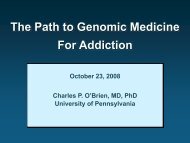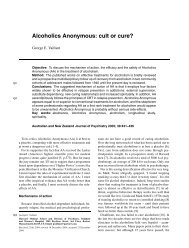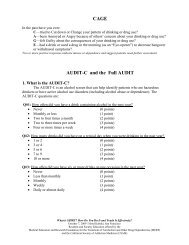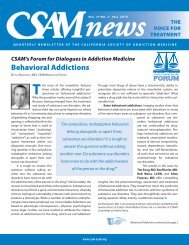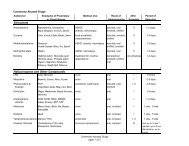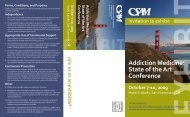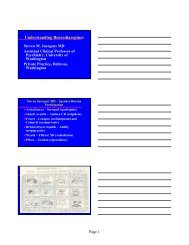SAN FRANCISCOMEDICINE - California Society of Addiction ...
SAN FRANCISCOMEDICINE - California Society of Addiction ...
SAN FRANCISCOMEDICINE - California Society of Addiction ...
You also want an ePaper? Increase the reach of your titles
YUMPU automatically turns print PDFs into web optimized ePapers that Google loves.
President’s Message<br />
Michael Rokeach, MD, and Steve Heilig, MPH<br />
Attorneys for the Afflicted<br />
Drug addiction—and let’s be clear from the start that we<br />
are talking about drugs both legal and illegal—has been<br />
likened to a form <strong>of</strong> slavery. A strong choice <strong>of</strong> words,<br />
yes, but not too strong for the impact severe addiction can have<br />
on a person’s life: helplessness, destruction, and despair are all<br />
common. To all that, add denial, both in the addicted person and<br />
among friends, colleagues, and our broader culture as a whole,<br />
and it’s not so surprising that the AMA years ago identified drug<br />
abuse, including that <strong>of</strong> alcohol and tobacco, as our nation’s biggest<br />
public health problem.<br />
San Francisco has long been known as a hard-drinking,<br />
hard-drugging town. This has been true from the Gold Rush<br />
onward through Prohibition and the 1960s Haight-Ashbury<br />
“hippie” explosion. Our city’s rates for abuse <strong>of</strong> substances<br />
from tobacco to heroin have historically been among the highest<br />
anywhere. Clearly there are many serious health and other<br />
consequences as a result.<br />
Thus it’s perhaps not surprising that San Francisco’s<br />
medical and public health leaders have long been pioneers in<br />
addressing addiction issues. SFMS advocates were movers and<br />
shakers in getting the AMA to make the statement referred to<br />
above; in the initiation, growth, and acceptance <strong>of</strong> addiction<br />
medicine as a legitimate specialty; in recognizing addiction as<br />
a disease with identifiable etiology, symptoms, and treatment;<br />
in the banning <strong>of</strong> smoking in restaurants (before the rest <strong>of</strong> the<br />
state and nation); in the acceptance <strong>of</strong> needle-exchange programs<br />
as a means <strong>of</strong> both interrupting transmission <strong>of</strong> HIV and<br />
as a bridge to treatment; in recognizing and treating physicians<br />
who themselves experience problems with drugs or alcohol; in<br />
developing sound approaches to the ongoing “medical cannabis”<br />
controversies; in raising awareness about emerging new drugs<br />
such as MDMA or “ecstasy” and others; in removing tobacco<br />
products from pharmacies; in advocating for justifiable alcohol<br />
tax increases to help compensate for the real costs <strong>of</strong> drinking;<br />
and more. It’s a long and, we feel justified in saying, impressive<br />
list <strong>of</strong> contributions.<br />
Sometimes this work has been local; sometimes it has<br />
involved taking our approaches statewide and beyond via our<br />
representatives to the CMA and AMA, as well as undertaking<br />
advocacy efforts with our elected <strong>of</strong>ficials and other authorities.<br />
As in other arenas, we have learned that physicians can be the<br />
most effective advocates <strong>of</strong> all. As the evidence base increases<br />
for the disease model <strong>of</strong> addiction and effective treatment and<br />
prevention, this becomes even more true.<br />
<strong>Addiction</strong> can strike people <strong>of</strong> all walks <strong>of</strong> life. But we will<br />
note that when physicians argue for better approaches and resources<br />
on behalf <strong>of</strong> some <strong>of</strong> their most afflicted patients, many<br />
<strong>of</strong> whom have been left with nothing other than hope, those physicians<br />
truly take on the role the legendary nineteenth-century<br />
physician and “father <strong>of</strong> modern pathology” Rudolph Virchow<br />
defined as “the natural attorneys <strong>of</strong> the poor.”<br />
We have been pleased and proud to turn over this issue <strong>of</strong><br />
our journal to two local guest editors who embody all that is<br />
impressive about the rise and success <strong>of</strong> addiction medicine.<br />
David E. Smith, MD, and David Pating, MD—”Big Dave and Little<br />
Dave,” as they have referred to themselves during this editorial<br />
process—are beyond renown in their specialty and community.<br />
Smith we should all know as the founder <strong>of</strong> the landmark<br />
Haight-Ashbury Free Medical Clinic, which he started right out<br />
<strong>of</strong> UCSF medical school. Pating is head <strong>of</strong> addiction medicine at<br />
San Francisco’s Kaiser Permanente. Both have been tireless advocates<br />
for their field, presidents <strong>of</strong> addiction medicine specialty<br />
societies, and holders <strong>of</strong> a dizzying array <strong>of</strong> positions wherever<br />
drug and alcohol policy, prevention, practice, and funding are<br />
debated. They exemplify the ideal role <strong>of</strong> the physician and<br />
clinician, researcher, and, yes, “natural attorney” for their own<br />
patients and those <strong>of</strong> others.<br />
There is already an <strong>of</strong>ficial David E. Smith, MD, Day in San<br />
Francisco, and someday there is likely to be a Pating Day as well.<br />
We all owe these two Daves a lot.<br />
They’ve assembled for us here an impressive monograph<br />
<strong>of</strong> addiction medicine. The authors herein, from the SFMS and<br />
beyond, pull few punches in describing what has been accomplished<br />
to date and what still needs to be done. The challenges<br />
remain, and some are daunting. But many <strong>of</strong> those who have<br />
experienced addiction, and beaten it, have identified hope as the<br />
single most important element in their recoveries. And what do<br />
effective treatment and more humane approaches to any lifethreatening<br />
malady <strong>of</strong>fer, if not hope<br />
www.sfms.org June 2010 San Francisco Medicine 7




